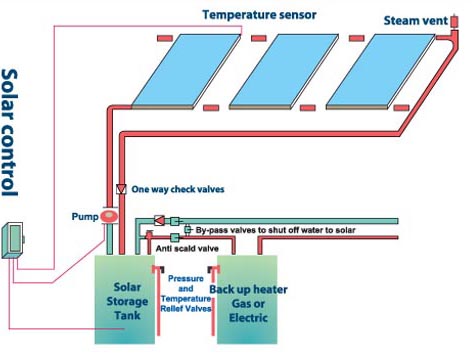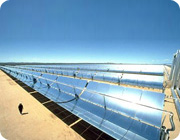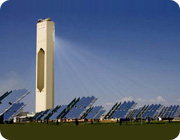ENERGY
Solar Thermal Energy
Solar thermal technologies can be used for water heating, space heating, space cooling and power generating as well.
Solar Hot Water Heating
The most common use for solar thermal technology is for domestic water heating. Hundreds of thousand of domestic hot water systems are in use throughout the world.
A solar water heater works a lot like solar space heating. In north hemisphere, a solar collector is mounted on the south side of a roof where it can capture most sunlight. The sunlight heats water in a tank. The hot water is piped to faucets throughout a house, just as it would be with an ordinary water heater.
In low geographical latitudes (below 40 degrees), 60 to 70% of the domestic hot water with temperatures up to 60 °C can be provided by solar heating systems. The most common domestic types of solar water heaters are evacuated tube collectors and glazed flat plate collectors; and unglazed plastic collectors used mainly to heat swimming pools.
A solar hot water heating system

Solar Space Heating
Space heating means heating the space inside a building. Today, many homes use solar energy for space heating. Solar space heating systems can be classified as passive or active.
A passive solar home is designed to let in as much sunlight as possible. It is like a big solar collector. Sunlight passes through the windows and heats the walls and floor inside the house. The light can get in, but the heat is trapped inside. A passive solar home does not depend on mechanical equipment, such as pumps and blowers, to heat the house.
An active solar home, on the other hand, uses special equipment to collect sunlight. An active solar house may use special collectors that look like boxes covered with glass. These collectors are mounted on the rooftop facing south to take advantage of the winter sun. Dark-colored metal plates inside the boxes absorb sunlight and change it into heat. (Black absorbs sunlight better than any other color.) Air or water flows through the collectors and is warmed by the heat.
Solar Space Cooling
The heat from a solar collector can also be used to cool a building by using solar absorption coolers. Solar heat is an energy source. Home air conditioner uses an energy source, electricity, to create cool air. Solar absorption coolers use a similar approach, combined with some very complex chemistry tricks, to create cool air from solar energy.
Solar Thermal Power Plants
Solar thermal power plants use the sun's rays to heat a fluid to very high temperatures. The fluid is then circulated through pipes so it can transfer its heat to water to produce steam. The steam, in turn, is converted into mechanical energy in a turbine and into electricity by a conventional generator coupled to the turbine.
So solar thermal power generation works essentially the same as generation from fossil fuels except that instead of using steam produced from the combustion of fossil fuels, the steam is produced by the heat collected from sunlight. Solar thermal technologies use concentrator systems to achieve the high temperatures needed to heat the fluid.
The three main types of solar thermal power systems are:
- Parabolic trough (the most common type of plant).
- Solar dish
- Solar power tower
Source: Sandia National Laboratories


